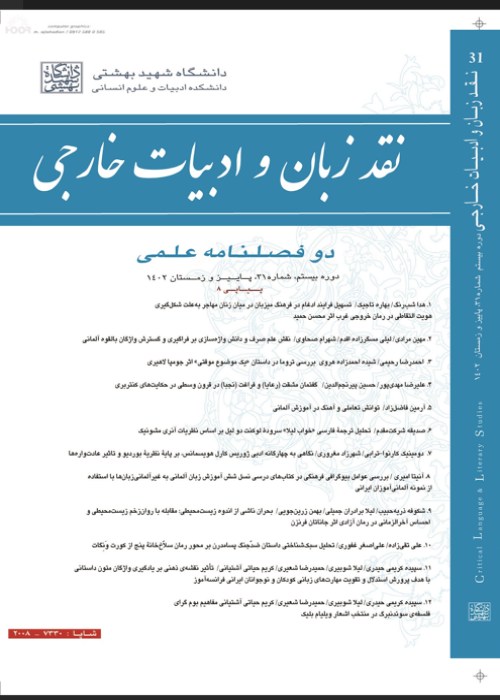A Study of the Concept of the Subaltern in Jhumpa Lahiri’s The Namesake
Author(s):
Article Type:
Research/Original Article (دارای رتبه معتبر)
Abstract:
Introduction
This article aims to investigate the different aspects of the concept of the subaltern in the major characters of Lahiri’s The Namesake in terms of Gayatri Spivak and Homi Bhabha’s theories. One of the important and central issues in cultural studies and postcolonial literature, which has received much attention in the recent decades, is the notion of the subaltern. It has been extensively discussed and debated by such postcolonial theorists as Spivak and Bhabha. Spivak believes that the subaltern cannot speak since the oppressor, one way or another, silences any voice that belongs to ‘the other.’ On the contrary, Bhabha adopts a rather optimistic view and proclaims that a hybrid and ambivalent identity can provide a space for the subaltern to speak and to be heard. The central questions of the article are: Can the components associated with the concept of the subaltern be traced in The Namesake? How do the main characters react to their portrayal as ‘the other’ and ‘the inferior’? Do they manage to ‘speak’ and construct an identity that negates ‘otherness’ and ‘inferiority’?
Background Studies
Most of the previous studies on Lahiri’s The Namesake have focused mainly on immigration, diaspora and immigrant women’s identity. For instance, in his doctoral dissertation titled Indian Americans as Native Informants: Transnationalism in Bharati Mukherjee’s Jasmine, Jhumpa Lahiri’s The Namesake, and Kirin Narayan’s Love, Stars and All That (2006), Ghaitree Aubeeluck analyses post-1965 Indian immigrant communities. He shows that these new groups differ from other ethnic immigrant groups as they seek and endeavour for certain rights that were denied to their predecessors. As another example, in a feminist study on The Namesake, titled "Immigrant Motherhood and Transnationality in Jhumpa Lahiri’s Fiction" (2007), Ann Marie Alfonso-Forero shows how traditional gender roles can be read as a source of empowerment when translated into the context of the middle class immigrant life in America. The article concludes that immigrant women need to be understood not only in the context of their particular national histories, but also in their appreciation of these histories in forging individual identities in America. Also, a large number of studies have examined the diasporic identities in Lahiri’s The Namesake. For instance, Lekha Roy and Khushu Lahiri’s article, "Forging Transnational Identities: A Postethnic Diasporic Re-imagining of ‘Home’ in Jhumpa Lahiri’s the Namesake" (2015), and Binod Paudyal’s article, "Reimagining Transnational Identities in Lahiri’s The Namesake" (2015), indicate how the South Asian diaspora participates in transnational networks, shaping and transforming the notion of American identity in the contemporary global era.
Materials and Methods
To answer the research questions, manifestations of the concept of the subaltern are analysed in the demeanour, identity and social interactions of Ashima (the main character of the first generation) and Gogol (the main character of the second generation). Ashima and Gogol’s conscious and unconscious strategies for liberation from subalternity and creation of a socially equal identity are also explored in this Cultural Studies research.
Results and Discussion
The article shows that in The Namesake, immigration affects not only the identity of the first generation immigrants but also the identity of their children. Subalternity is discernible in Ashima’s arranged marriage, her sheer dependence on her family and husband, pregnancy, immigration and also in Gogol’s name and his relationships with white Americans. Ashima, who initially rejects the Western culture, gradually comes to embrace it and adapt herself to it. Also, Gogol who always shunned his true identity and cultural roots, in time takes interest in Indian culture. The article also indicates that hybrid and ambivalent identities create a voice for subalterns and give them a sense of power and belonging, so much so that they become ‘the self’ (in contrast with ‘the other’) in the new cultural context. This implies that in The Namesake, Bhabha’s conception of the subaltern and the possibility of his/her speaking is more pertinent than Spivak’s.Keywords:
Language:
Persian
Published:
Critical Language & Literary Studies, Volume:16 Issue: 22, 2019
Pages:
165 to 190
magiran.com/p2008838
دانلود و مطالعه متن این مقاله با یکی از روشهای زیر امکان پذیر است:
اشتراک شخصی
با عضویت و پرداخت آنلاین حق اشتراک یکساله به مبلغ 1,390,000ريال میتوانید 70 عنوان مطلب دانلود کنید!
اشتراک سازمانی
به کتابخانه دانشگاه یا محل کار خود پیشنهاد کنید تا اشتراک سازمانی این پایگاه را برای دسترسی نامحدود همه کاربران به متن مطالب تهیه نمایند!
توجه!
- حق عضویت دریافتی صرف حمایت از نشریات عضو و نگهداری، تکمیل و توسعه مگیران میشود.
- پرداخت حق اشتراک و دانلود مقالات اجازه بازنشر آن در سایر رسانههای چاپی و دیجیتال را به کاربر نمیدهد.
In order to view content subscription is required
Personal subscription
Subscribe magiran.com for 70 € euros via PayPal and download 70 articles during a year.
Organization subscription
Please contact us to subscribe your university or library for unlimited access!


